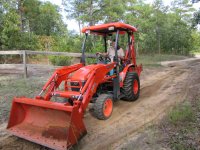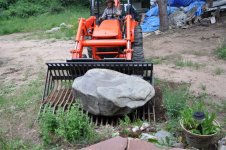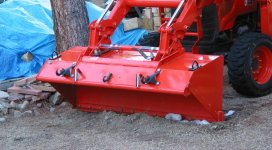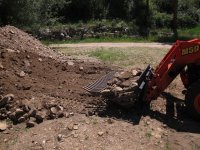Glad you are having fun.
Lets see... I'd be surprised if it could handle a six foot box blade. You might get more done with the 5 foot if you plan to pull it clear full. But there are no rules here because box blades depend on how you use them. Construction style dirt work uses a smaller box blade than gravel driveway maintenance for example. I tend to use the box blade more for ripping, and then turn around and use the FEL for picking up the loosened soil. Most smoothing I do by back-dragging the FEL bucket rather than with the box blade. So my box is basically a ripper. There's an art to back-dragging or using a box blade to accomplish the same finish work - and I'd say which you prefer depends on which you find works best in your soil.
Our ground is rocky, and lately I've been doing less and less with the 3pt and more with the FEL because the SSQA allows quick switching between the regular FEL bucket and a skeleton type rock bucket to break up soil and sort rocks. Or sometimes I will break up the ground with the hoe before turning around an picking it up with the FEL.
All of which is just a long-winded way of saying I don't do that much with the 3pt anymore so I'm out of touch with that. In fact, the next implement I get will probably be the 4n1 bucket. After a lifetime of working looking over my shoulder at a 3pt implement, I have fallen in love with working facing forward.
Before going to the backhoe QA, give your old traditional pin-on a try. With the lighter weight backhoe buckets on yours I think you may find that the pin-on is almost as fast for changing BH implements as the QA. It's basically two light weight pins instead of one. It helps to have some tapered pins to help line things up. I have two buckets for the
M59 - both are real heavy so QA on that size makes sense. But in our soil it doesn't make all that much difference which size bucket we use. I'll often use the smaller of the two just because it is more accurate, nearly as fast, and the records I'm trying to set are more about how much fun the job is, not how fast it gets done.
Looking at the "Build your Kubota" site, Kubota does offer a set of 36" pallet forks on an SSQA for the FEL. I don't know how that would compare to the EA forks. It depends on how they mount. You want forks mounted close. I dont have a set of pallet forks right now, and now that we are done building probably won't add them. There sure were times I wished for them - but right now we aren't expecting to be moving pallets.
On rear hydraulics, it kind of depends on how much you like to keep everything original Kubota. Remember that if you have a single remote with the abilty to be set for constant flow, it can be used to power as many hydraulic circuits as you like - three on a multiple valve stack is common - until eventually the added flow resistance makes it all too slow.
I like having the third function for the FEL, but if I had remotes for the rear I probably wouldn't use them.....But then I grew up with manually adjusted 3pt implements on which the only power adjustment was the ground engagement. So I am comfortable working a 3pt that way and think of TNT as a kind of toy - of course it's all a toy anyway, but the point being that manual adjustment does work well for 3pt implements. Give it a try. You may find that the real keys to 3pt implements is not the TNT so much as #1 being the weight - more is better and lots more weight is better yet. And #2 is a smoothly responsive 3pt lift.
There is an intermediate step between the basic threaded wrench adjusted tilt and top adjustments on the very basic Kubota 3pt hitch and the full power fingertip convenience of hydraulic T&T.. You rarely hear about it anymore, but the intermediate folding crank was my favorite. It works by replacing the wrench adjustable top and side link replacements links on the 3pt with ones that have a simple folding hand crank adjustment for T&T. Look around at older US equipement and you are likely to see 3pts that have those cranks.
Perhaps someone still makes that as an option - at one time it was very popular. You simply set the implement on the ground, adjust top and tilt with the handy folding hand cranks, and are good to go. I find with 3pt implements I'm likely to be back there several times getting the implement set up right anyway. Cranking in the right amount of T&T is easy. It's an option to think about. At this point I would start with the wrench adjustment on the 3pt when you finally get it.. and see then what you want to do.
Enjoy!






